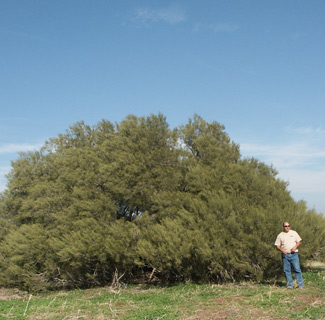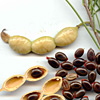Acacia sclerosperma F. Muell (Limestone Wattle, Silver Bark Wattle) is a large bush that reaches a height of 4 m and a diameter of 6 m. It is conspicuous in the Negev with its roundish and broad crown, but is also planted in KKL (Jewish National Fund) forests in other areas. It is identifiable through its crown and its phyllodes, which are long and narrow with a rectangular cross section. Contrary to the phyllodes of other Australian Acacia species, they reach a length of 14 cm and a width of 1.7 cm. The shape of the phyllodes imparted the Limestone Wattle with its Hebrew name, “Needle-shaped Acacia”. Another sub-species of this Acacia grows in Australia, with broader phyllodes.
Phyllodes are petioles which have broadened and look like leaves and fulfill the function of photosynthesis instead of the leaflets which have disappeared. During their evolutionary past, Acacias that grew in Australia had double-pinnate leaves, like the African and American Acacias. This phenomenon can be observed in the seedlings of Acacias that originate in Australia, where the leaves are bipinnate. Only the phyllodes remain in the mature leaves.
In Israel, Limestone Wattle blooms in the spring in round yellow inflorescences. One of the signs that single it out are fruits in the shape of an elongated and curved legumen whose shape is like a string in which the axis of the long legumen connects the broad seed-carrying parts. The legumen is approximately 10-15 cm long and up to 2 cm wide and carries 5-6 seeds. The species’ name, sclerosperma, means “hard seeds”. There is a soft red body that contains proteins at the base of the seed, which is regarded as a source of food which draws ants to collect the seeds and disperse them.
Limestone Wattle originates in desert regions of the northwestern part of Western Australia – a region with a climate and soil similar to those where it was planted in Israel. Its habitat in its place of origin is in areas which undergo transient flooding or in wadi ravines.
In Israel, Limestone Wattle was planted in desert and semi-desert regions and served as plant cover. This species, similarly to other Acacia species which originate from Australia (Acacia saligna – Sydney Golden Wattle, Acacia salicina, Acacia victorae, etc.), is an imported plant and is regarded as an invasive plant in Israel. The KKL has therefore ceased growing it in its nurseries or planting it, already in the early 1990s.
In other places around the world it serves as a source of food for cattle, as firewood, and as a plant for preventing erosion.
Written by Zvi Avni





